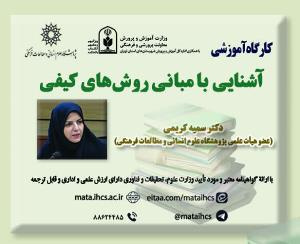قالب های هنری دین در زیبایی شناسی هگل و دلالت های تربیتی آن؛ انعکاس در هنر مجسمه سازی (مقاله علمی وزارت علوم)
درجه علمی: نشریه علمی (وزارت علوم)
آرشیو
چکیده
هنر، دین و فلسفه با یکدیگر دارای روابط عمیقی هستند. فلسفه هگل یکی از مظاهر آمیختگی این سه مقوله است. هنر مجسمه سازی را می توان یکی از جلوه گاه های این نوع هنر دانست. در این پژوهش از نمونه گیری هدفمند استفاده شده است. روش پژوهش مورد استفاده روش استنتاجی فرانکناست. در این روش در ابتدا محقق به استنتاج اصل تربیتی از هدف غائی و گزاره واقع نگر مبنایی پرداخته و سپس به استنتاج روش تربیتی از اصلی که در استنتاج پیشین به دست آمده و گزاره واقع نگر مصداقی پرداخته است. حوزه پژوهش شامل کتاب های هگل، سایر منابع و پژوهش ها حول محور مفاهیم زیباشناسی هگل، مبانی نظری زیباشناسی وی و زمینه های تربیتی آن است. یافته های این پژوهش حاکی از آن است که بیان ژرف ترین ارزش های ذاتی هر تمدن و آشکارسازی ایده مطلق ازجمله اهداف اساسی تربیت زیباشناسی استنتاج شده از نظرات هگل است که نیل به آن در گرو استفاده از اصولی چون شیوه بیان ارزش های ذاتی هر تمدن متناسب با دوره تاریخی خود است که شیوه بیان هنری، دینی و فلسفی و ارتباط آنها با یکدیگر از روش های رسیدن به این اهداف و اصول است. همچنین رساندن انسان به حد کمال و حقیقت غایی از دیگر اهداف اساسی تربیت زیباشناسی هگل است که انتقال و اشاعه باورهای دینی از اصول آن و استفاده از قالب های هنری سمبولیک، کلاسیک و نمادین به منظور بیان اعتقادات دینی ازجمله روش های آن است. اهداف پژوهش استنتاج اهداف تربیت زیباشناختی هگل با بررسی قالب های هنری دین در زیباشناسی وی. استنتاج اصول تربیت زیباشناختی هگل با بررسی قالب های هنری دین در زیباشناسی وی سؤالات پژوهش کدام اهداف تربیت زیباشناختی را می توان از اندیشه های هگل استنتاج کرد؟ کدام روش های تربیت زیباشناختی را می توان از اندیشه های هگل استنتاج کرد؟Symbolic art style in Hegel's aesthetic ideas and its reflection in the art of sculpture
This study analyzed the artistic forms of religion in Hegel’s aesthetics and its educational implications. First, the relationship among art, religion, and philosophy and their positionin Hegel’s aesthetics were discussed. Then, the artistic forms of religion in Hegel’s aesthetics were explained, and finally, educational implications,which can be used in the educational system,were deducted from the discussion.This study used purposive sampling and Frankena's deductive model.In this model, first, the educational principle was deducted from the ultimate goal andrealistic basic proposition. Then, the educational principle was deducted from the principle obtained from the previous deduction and realistic extensional proposition.The study scope included Hegel's books and other sources and studies conducted on the concepts and theoretical foundations of Hegel’s aesthetics and its educational implications.Findings showed that expressing the most profound intrinsic values of any civilization and revelation of the absolute idea are among the basic goals of aesthetic education deducted from Hegel's views. Achieving these goals involves using such principles as the manner of expressing the intrinsic values of any civilization corresponding to its historical period. The manner of artistic, religious, and philosophical expressions and their relationship with one other play a part in achieving the said goals and principles.Leading man toward perfection and the ultimate truth are among other major goals of Hegel's aesthetic education whose principles are propagation and transmission of religious values, which are achieved through different methods such as using classical and symbolic art forms to express religious values.







